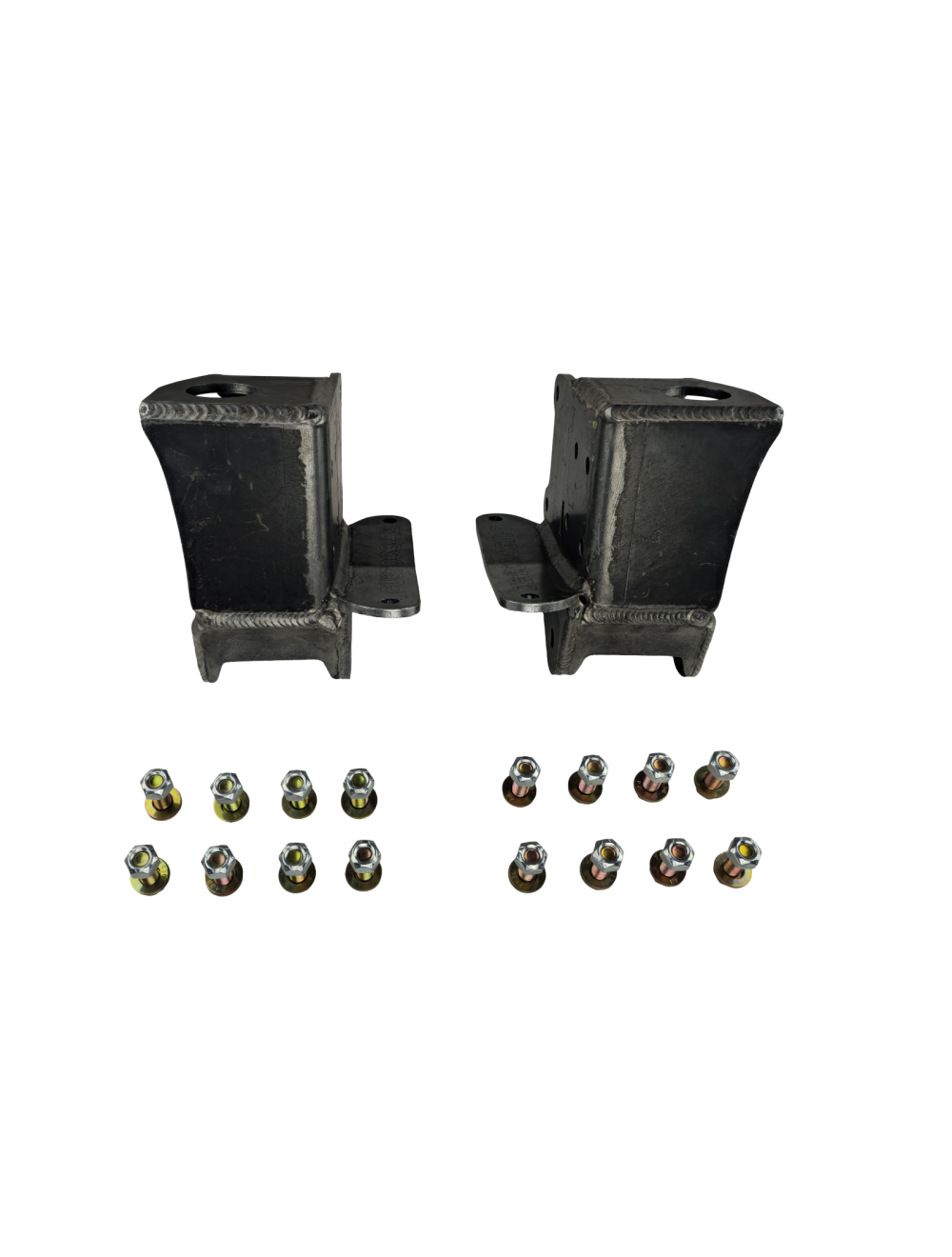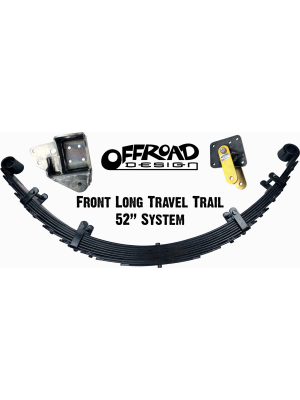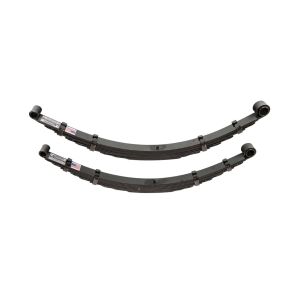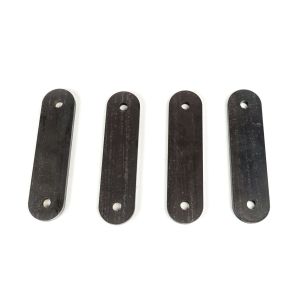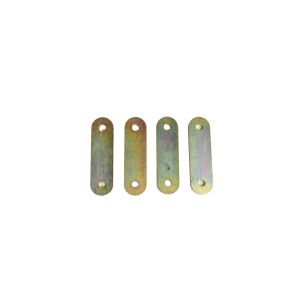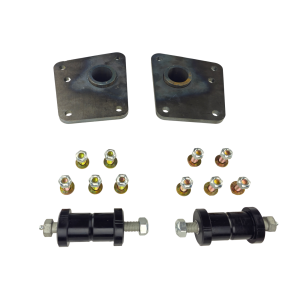Long Travel Trail 52" System Front Main Eye Spring Hangers for 1973-1980 GM 2WD to 4WD Conversion Trucks, Pair
This bracket is only for 52" front spring swaps. Please read information about this below!
To be used with our Front Upper Shackle Hanger for 52" Front Springs: click here
If you are looking for a 47" spring main eye hanger, please click here.
LTT52 System (Long Travel Trail 52" System)
Questions and Answers
Maybe I can answer a few questions at once. 52s are for a person looking for maximum flexibility from the front suspension. You have to be willing to run a custom spring like our ORD customs or build you own custom pack from parts of other springs. If you’re looking for maximum wheel travel for go fast situations, you’ll probably want to look at jumping ahead to our coilover systems for the steering precision and control necessary to really enjoy higher speeds in the rough.
Should I put 47” springs or 52” springs on my truck?
Are you going to be using custom leaves from ORD or are you willing to build you own spring packs from other spring parts? If so, 52s might be for you.
Are you looking for absolute maximum flex from your suspension? If so, 52s might be for you.
What applications are good for 47” springs? And 52”s?
52s are for a guy looking for maximum offroad flex but not looking for best handling at higher speeds. The system can be ideal for flex on a budget if you’re willing to do the work customizing your own spring packs.
Where does it put my axle compared to factory?
ORD brackets are designed to put the axle in the stock location on the truck with a stock 26” spring front section.
Can I use stock 52” springs? How much lift does that give me? Are all stock 52” springs the same?
In general, a stock rear spring in the front of a squarebody will give about 4” of lift. All stock 52s are not the same. There were quite a few different springs available on different types of trucks and 52s were used on everything from 2wd shortbeds to some pretty heavy rated 3/4T trucks. And obviously there are a wide range of weights from the front of these trucks since a K5 with an aluminum engine is a whole different story from a Cummins swapped crewcab. There is not a stock rear spring that is a really great option to just bolt into the front without doing some customizing on the spring pack. Generally this involves removing an overload and mixing in more leaves from another spring pack to make them match what you need.
Can you build stock height front 52” custom springs?
When we build our ORD custom leaf packs, we just work off the height you’re looking for. If you want a 4” lift with 52’s, that’s what we build. We don’t confuse the matter by guessing what height they would be on the rear of a truck. So, just keep it simple and think about what lift you want on the front and that’s what we’ll build for you.
Does it give me better ride quality?
In our Custom springs, 47s (really 48”) and 52s will ride very similarly. When you’re comparing a spring pack that you have built yourself, it’s hard to know what you will have and what to compare to. In general, you’ll end up with a spring system that if anything is extra soft and that will tend to ride well.
Does it give me more wheel travel? How much?
Reference the “book” below
What additional parts are needed? X-Over? Extended Shock Mounts?
In general, you’ll need to run a longer travel shock to take advantage of the extra spring travel. Crossover steering is definitely required. A high quality shock and maybe an adjustable or tunable shock would be a good idea. Soft spring rates on these trucks will tend to require more damping to keep the truck under control. Similarly, a sway bar like our crossover specific sway bar is a good idea since the narrow spring base on these trucks doesn’t help body roll.
Axle wrap? Traction bar? Panhard bar?
Axle wrap is a serious concern with 52s since it’s easy to end up with a spring that essentially just too soft. It’s hard enough with a spring like our Custom system so it’s something to watch out for. Once again, if you have a heavy, high powered truck that you use hard offroad, no leaf system is going to be amazing. It’s generally very difficult to make a front traction bar system so front spring wrap is handled by the spring.
We generally don’t recommend a panhard bar since it forces the axle to move side to side and that can be hard on frames and brackets. With short travel systems and low ride heights, it can be made to work but 52’s are exactly meant for short travel systems…
What’s the lowest lift height I can do with 52” springs? The tallest?
2-3” of lift could be considered a minimum and with our ORD Custom springs, 7” would be a maximum. If you’re building your own custom pack, the sky is the limit!
Can I do high steer and crossover between 2-12? Of lift?
You have to run at least a crossover steering system and ability to fit high steer (tie rod over the springs) comes down to spring pack thickness, caster angle and axle placement. Basically the same criteria as fitting high steer with a stock length leaf system.
Am I more likely to damage my springs with 52’s? Bumpstops?
All spring systems need limiters of some sort and 52s are not different. Run a bump stop in the right location and it’ll help keep them from over stressing and bending. Flex is good, bending is not. We can give you solid guidelines for bump stop placement for our custom springs.
Pros:
- More vertical wheel travel is available. The best comparison is our ORD custom springs in the standard mount locations vs. our springs in 52” locations. In stock mounts, we get 9.5-10” of travel, and with the 52” mounts, we get 11 to 11.5” of vertical travel. Net is roughly 1.5” of vertical wheel travel.
- If you are creating your own custom spring pack by cutting apart multiple packs and combining them, you can end up with a good soft spring with reasonable durability and good travel for the cost of junkyard spring packs. There can be a lot of value here.
Cons:
- You can’t really just bolt in a stock rear spring and expect it to work optimally. You need a custom-built spring of some sort, either our ORD Custom springs or build your own.
- A stock rear spring with an overload can easily act too stiff when the weight of the front of the truck pushes the spring down on the overload at regular ride height. If you remove the overload and don’t build out the spring with more leaves, they end up too soft, very prone to spring wrap, and have a very short life. Figuring out what to build is generally a trial-and-error system, meaning that you should have some idea of what you’re doing upfront to make this work.
- Very soft leaves on these trucks will cause body roll problems since they’re mounted so narrow on the axle. An example is a longer travel coilover system that uses comparatively very soft springs, but they’re mounted several inches outboard on each side for a much wider spring base which adds a lot of roll stability. Unfortunately, you can’t mount leaf springs out by the knuckles so the very narrow spring base means a soft leaf will give a LOT of body movement. Once again, proper spring tuning can make this less of a thing, and good shocks and sway bars will also help.
- Approach angle can be a problem on hard trails. We’ve seen people have VERY long frustrating days on the trail running the front of a 52” leaf spring into every obstacle we encountered. The front of a 52” spring will stick out 2.5” more than an equivalent spring in a stock mount. This is a problem in a small tire trail rig.
- Crossover steering is a requirement. Stock type push-pull steering doesn’t work with 52s.
- Steering again… Some bump steer is inherent in a leaf-sprung vehicle with crossover steering. The more wheel travel you use and especially at taller lift heights (over 3-4”), the worse the bump steer gets. It can reach some truly eye-opening levels. Be prepared.
- The costs can add up. If you’re looking for extended wheel travel to use at higher speed off-road, you need a good shock system, and by the time you buy hangers, shackles, and a good spring to get the longer wheel travel, you’ve spent a decent amount of the money it takes to buy our 4-link coilover system, which will give you WAY more overall performance. We do understand that installing a coilover system isn’t trivial, and that can make a difference.
You’ll notice there are only a couple of pros and a lot of cons for this system. To explain this a little, we’ll talk about where the idea for this spring system came from. In the beginning…. Some guy figured out that you could shuffle some bracket locations on the front of a square and move the main eye mounting point forward. It wasn’t hard to move the shackle mounting point back and the old stock springs he had laying around could fit up front and man were they soft and flexy, especially at a time when custom packs were a lot harder to come by and you were comparing them to some ridiculously stiff lift kit springs. The priority was trail use so crossover steering was already part of the equation and replacing springs regularly or figuring out how to build a custom pack was still next to free so it was all fine. This is really the root of it, the cheap cost of the spring and being willing to put in the labor to customize it or deal with the frequent problems. So that was and is the primary advantage of the longer spring system. The base spring is cheap or free. It’s really a big pro, if you’re the guy with the skills and patience to make it work. When you start buying new springs and possibly still have to customize them on top of needing bracketry to make it work, the budget advantage just isn’t the same.
The single other advantage is the extended wheel travel you get from the longer spring length when you have an appropriately built spring pack. Realistically, you will never see that advantage to the longer spring on the street, in a camping truck (overlanding) situation and maybe not in every rock crawling situation. The longer springs won’t hurt in those situations, but you shouldn’t go out of your way to make 52s happen. They’re really good for a guy that wants to run rougher trails and push the speed a little bit and doesn’t have the resources for a link system, yet.
Leaf Spring Length and Ride Quality
Let’s jump right in. These two things are not directly related. A longer leaf spring will not give you a softer ride. Period. If this was true, a 6-foot-long spring from a dump truck could be bolted to your half ton and it would ride great. It obviously will not. It doesn’t matter that it’s 6 feet long, what matters is that it’s from a dump truck. Same thing with swapping 56” leaves into lighter duty trucks. The longer springs were largely built for heavier rated 3/4T and 1-ton trucks and bolting them into a K5 isn’t going to change that. So what I’m saying here is there are other factors that are more important than the spring length.
Let’s step back a second and define some ride quality zones. The one that matters to most people is generally on road driving. This would include rough city streets, railroad crossings, minor washboards and potholes on dirt roads, and so on. This type of driving will typically use 6” or so of moderately soft wheel travel. A next step is rougher dirt road, minor washouts and moderate speeds, in general terrain that would not bottom a system with 8-10” of wheel travel. This is where we would classify most of your unimproved back country roads that people use for camping, hunting, fishing, etc. The last step is anything more, whoops, larger rocks and rubble on a “road”, terrain that most people would consider rock crawling, etc. This is where more wheel travel, large shocks with bypass systems, hydraulic bumpstops and precise wheel control all become important factors.
What leaf spring length does give you is possibility of more spring travel. Not guaranteed more travel but it’s possible because the longer the piece of material is, the more it can flex before it bends. Now, when we start looking at the types of driving where more wheel travel really matters we can get an idea of when long spring conversions make sense. Our ORD Custom leaves give roughly 9” of vertical wheel travel on the pre ’72 trucks with 44” front springs and a little more than that on the 73+ trucks with factory 47” springs. These systems provide really good (amazing really) ride quality in the first 2 ride scenarios and aren’t terrible even with more aggressive use. You DO NOT have to use an extended length spring to get a soft spring rate and good ride quality in most situations. We can absolutely build stock length springs soft enough for good ride. If you’re looking to push the limits more, we have extended length systems to put a 52” spring in the front and with our custom springs you will get more wheel travel but keep in mind the situation where that is actually a benefit, it’s going to be in more extreme use.




